by Jason Ball
Overview
The giant puffball mushroom (Calvatia gigantean) has a lot of culinary potential. One of our most surprising and successful techniques involved rubbing pieces of puffball with shio-koji, compressing them and curing them like meat. The result was a potent ‘cheesy’ umami bomb (to be used sparingly). We developed some dishes to explore the applications of this curious, unique ingredient.
One late afternoon towards the end of July 2014, we found ourselves holding a few giant puffball mushrooms (Calvatia gigantean).
We happened upon these mushrooms by accident. Avery and I were foraging for elderberries when we stumbled upon a row of giant puffball mushrooms. To call them ‘giant’ puffball mushrooms is completely appropriate—they are larger than a basketball (though much less dense) and very rotund. We had already loaded 10 kilos of elderberries onto our bikes, but we couldn’t leave these beauties behind. We gathered them and rode back to the boat.
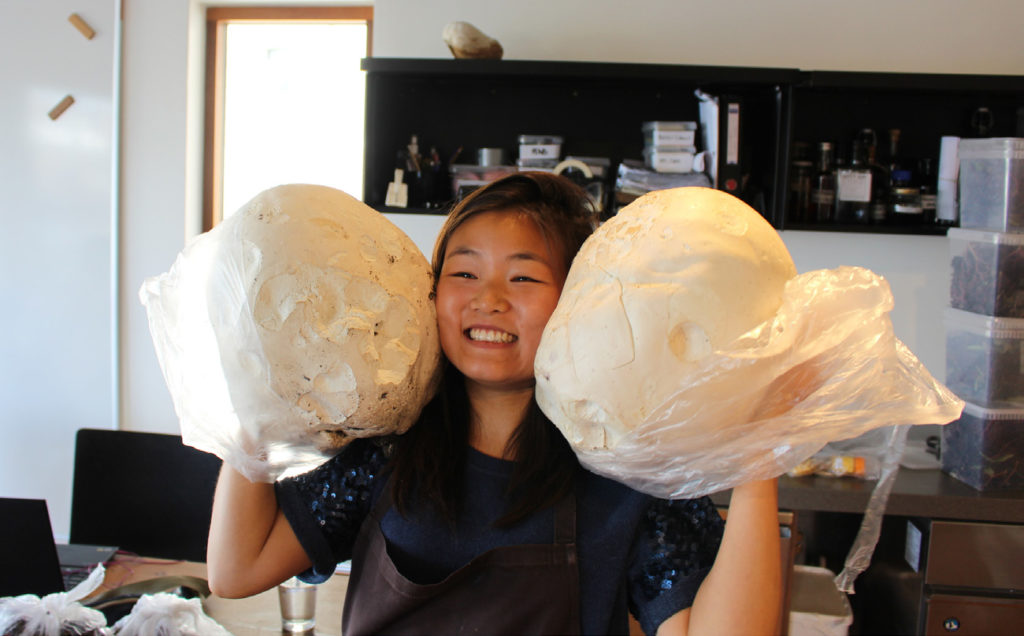
The puffball mushroom is a gasteroid fungus (gastro is Greek for ‘stomach’), within the larger family of Basidiomycota. Basidiomycota form the second-largest group of fungi, with more than thirty-one thousand described species. They are defined by the production of sexual spores on basidia. Basidia are mostly club-shaped cells with four small outgrowths called sterigmata. The sterigmata produce one spore each. Gasteroid fungi are Basidiomycota that produce their spores inside—in the ‘stomach’. They never actively shoot their spores from the basidia but rely on some outer force—like an animal or the splashing of raindrops—to get the spores airborne (Peterson, 2012). It is unclear to us how these particular puffball spores became airborne, but as we found them the mushrooms were growing in a completely straight line.
Although their unusual appearance of the giant puffballs makes them rather recognizable, it is of the utmost importance to make sure any foraged wild mushroom is edible before beginning to work with it.
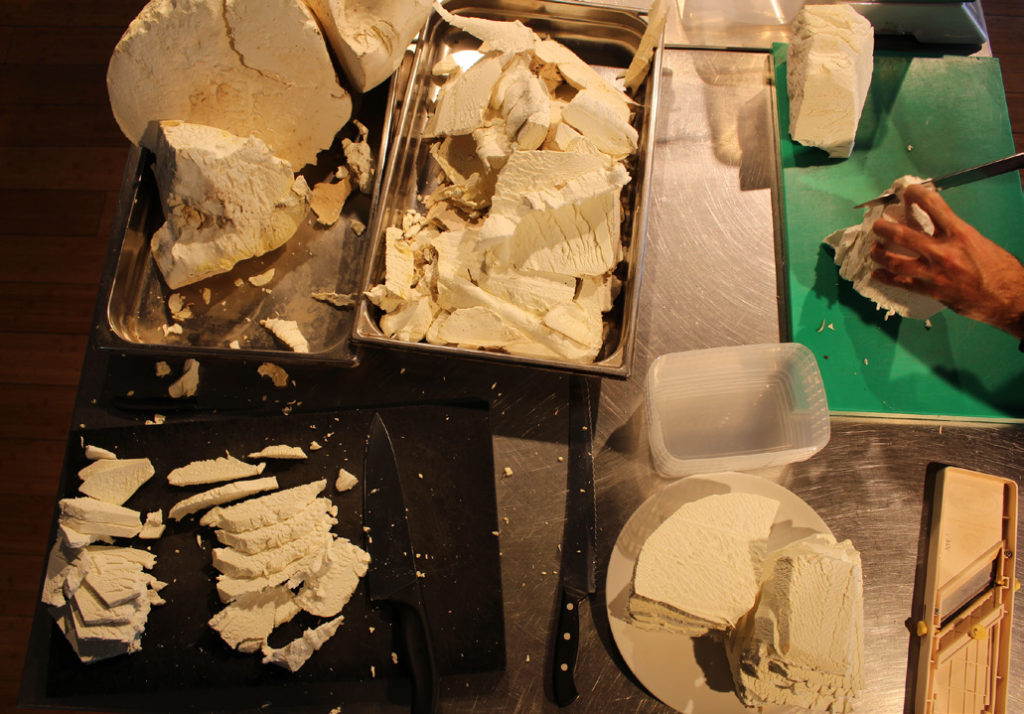
The estimated number of mushroom species growing in Europe ranges from 2000 to 1.5 million (Eren et al., 2010; Poucheret et al., 2010). As we have repeatedly mentioned in previous posts, where foraging is concerned, proper identification is standard protocol before consuming anything that is foraged in the wild. Disregarding intentional consumption of psychoactive mushrooms, ingestion of toxic fungi is mostly accidental. Mushroom poisoning resulting from a suicide attempt or a criminal act is a rare event (Karlson-Stiber & Persson, 2003). Common sense dictates that an expert opinion is warranted if you are unsure. Just like that old saying, ‘When in doubt, throw it out’. We have one too: ‘If you don’t know what it is, don’t eat it’.
Although every ‘mushroom hunters’ guide warns its readers against collecting unknown or not well-known fungi, several ‘old wives’ tales’ like testing the fruiting bodies with a silver spoon or checking for insect damage are still used to distinguish edible and poisonous mushrooms. These practices together with tasting unknown edible mushrooms can lead to severe mushroom poisonings because: (a) macro-fungi can hardly be reliably identified by comparing pictures in a field guide with specimens from the wild, (b) the gastronomic value of rarer species is often not known, and therefore (c) new poisonous species are discovered occasionally (Kirchmair et al., 2012).
The two most notable and obvious giant puffball look-alikes are Amanita and Scleroderma. Actual puffball mushrooms are quite soft, almost cloud-like, on the interior, whereas Scleroderma (as the name would suggest) are firm and hard inside. Amanita have an outline of a capped mushroom shape on the interior. Both are extremely toxic, and in most instances, fatal if consumed—though some Amanita species, like Amanita muscaria, can be detoxified by simmering in boiling water (Rubel & Arora 2008). In recent decades, mushroom poisoning cases caused by lethal Amanita spp. have been frequently reported, which account for over 90% of all fatal mushroom poisonings worldwide (Bresinsky & Besl, 1990; Ward et al., 2013; Roberts et al., 2013; Chen et al., 2012; Unluoglu & Tayfur, 2003).
We are fortunate enough to be in communication with mushroom foraging experts, and determined that these mushrooms were, in fact, safe to eat. For Calvatia gigantean the interior should be pure white. This is a good indication that the puffball mushrooms are fit for consumption. If the interior of the mushroom has any discoloration or streaks of yellow, it should be discarded.
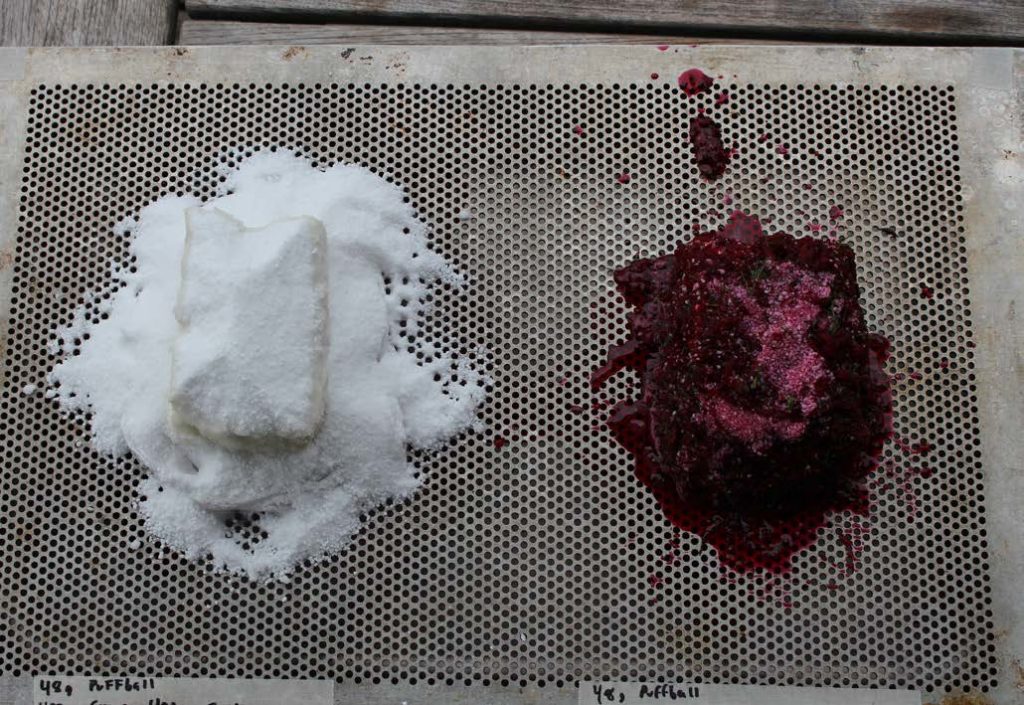
The culinary potential of these mushrooms is great, but there is and has been interest in the fungus for other purposes, such as the medicinal and pharmaceutical industries. Berkley (1857) reported that Calvatia gigantea and Calvatia caelata could be used in burn cases due to their anesthetic properties. Berkley (1857) also states that the application of C. spp. stops bleeding from wounds. The scientific community’s interest in mushrooms has continued to develop since. Out of approximately 15,000 known species, 2000 of mushrooms are safe for human consumption, and about 650 of these possess medicinal properties (Rai et al., 2005).
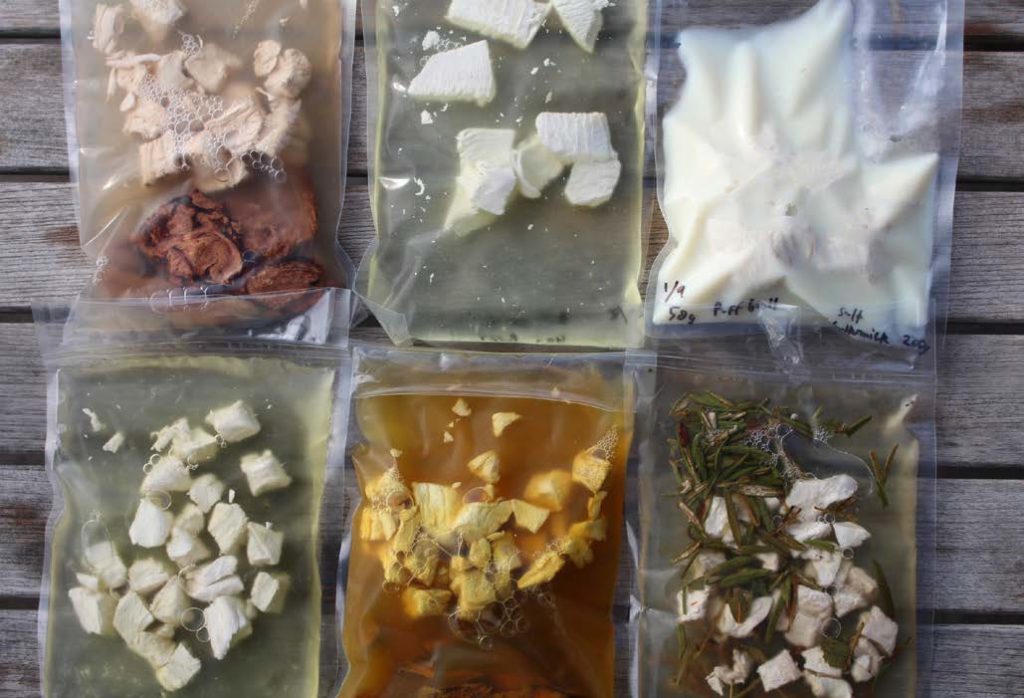
When talking about mushroom deliciousness, we often find ourselves on the topic of amino acids. Of the amino acids, there are 23 that are proteinogenic. These are the amino acids that form peptide chains that provide the ‘backbone’ for protein formation. Of these 23 proteinogenic amino acids, only 9 of them are considered ‘essential’—since we cannot synthesize them, we must obtain them from food. Kivrak et al. (2014) detected all 9 essential amino acids (histidine, isoleucine, leucine, lysine, methionine, threonine, tryptophan, valine, and phenylalanine) in puffball mushrooms, as well as all the non-essential amino acids with the exception of cysteine. And where there are many amino acids, there is often umami potential.
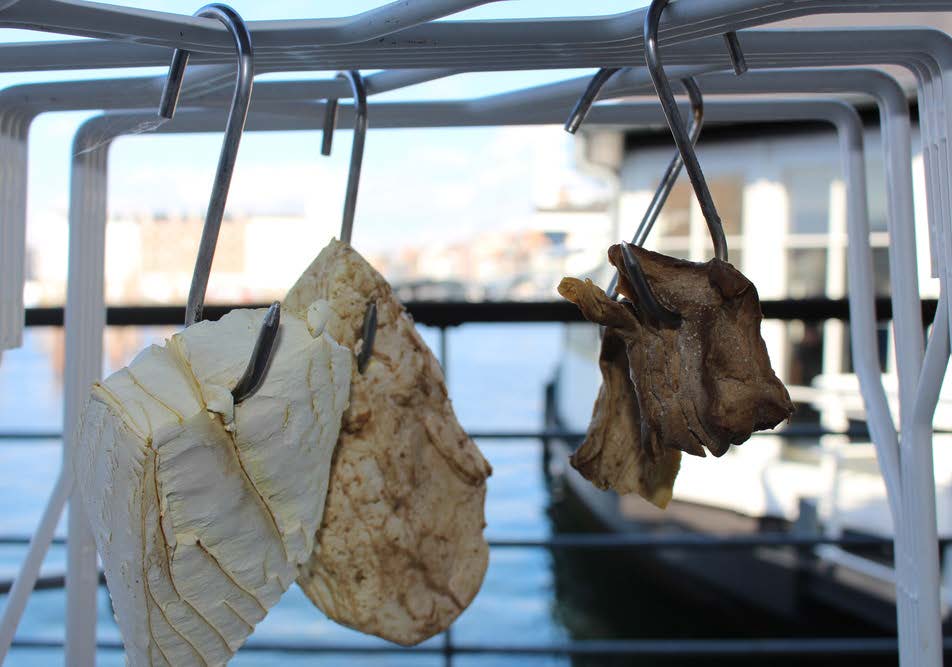
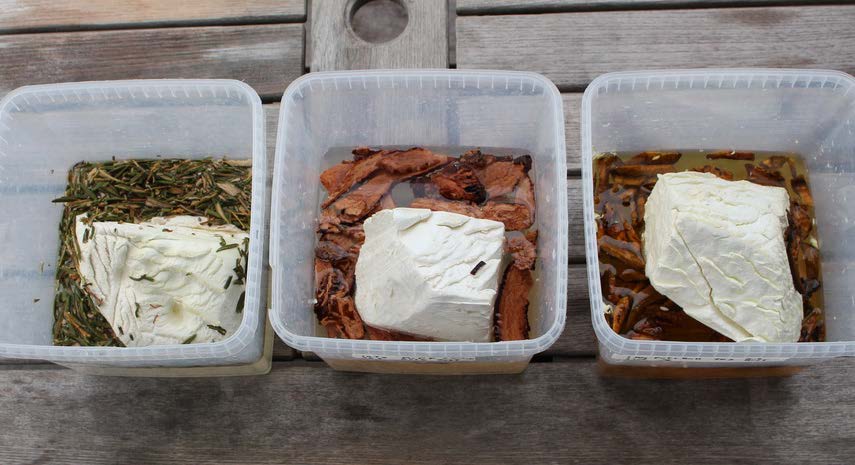
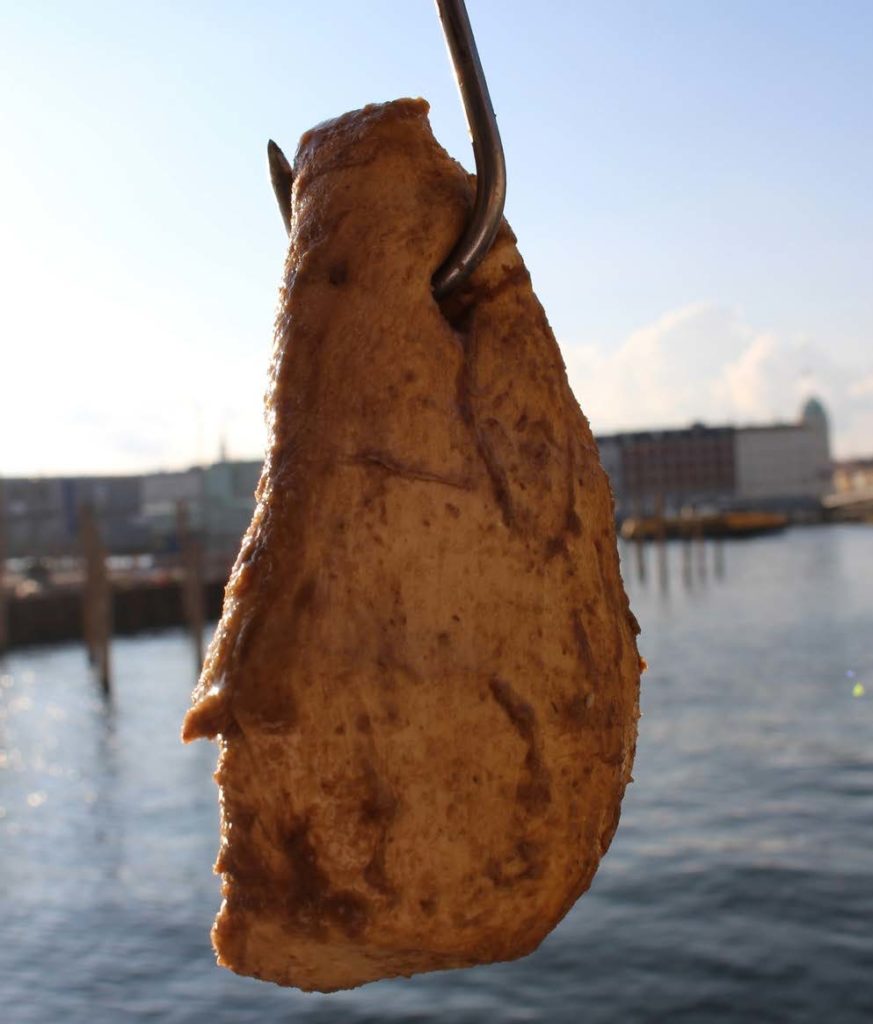
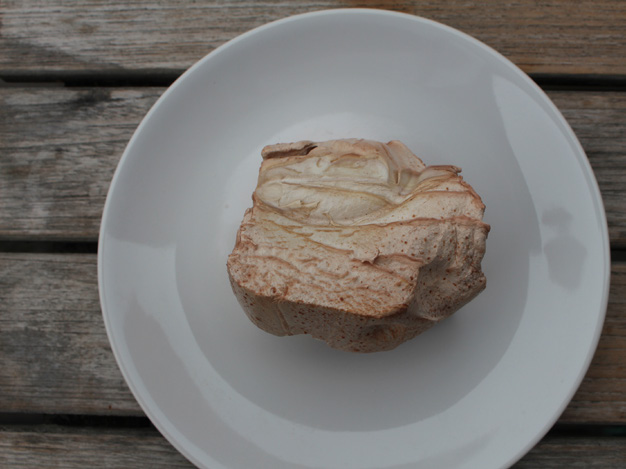
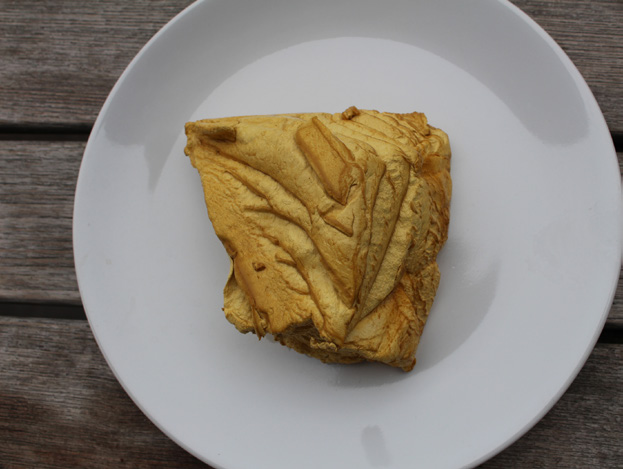
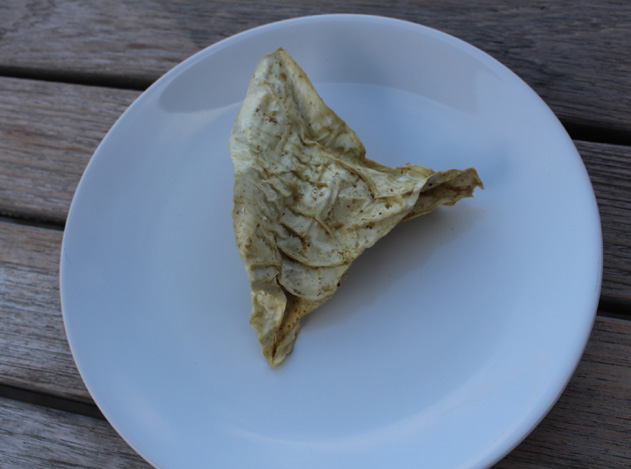
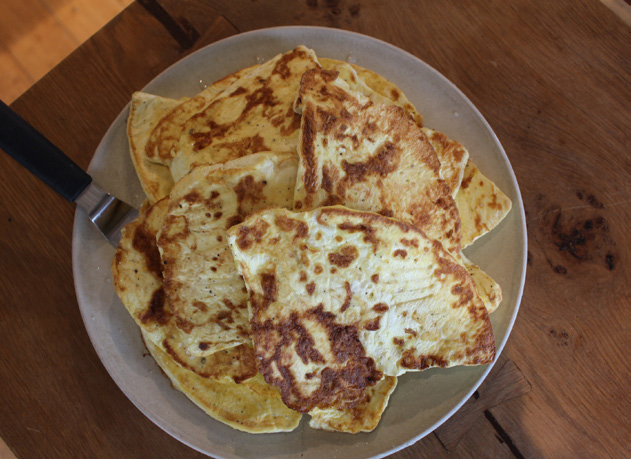
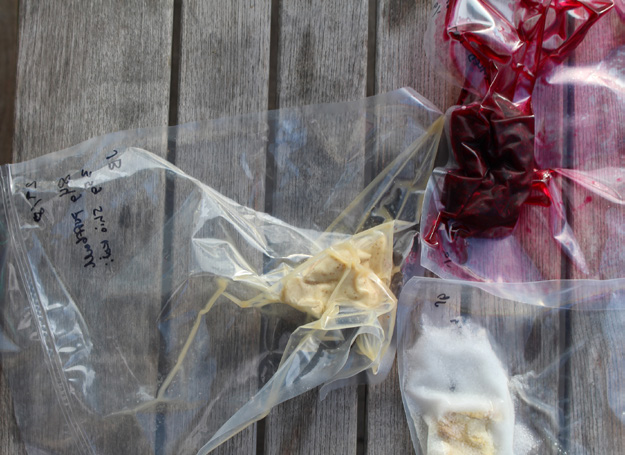
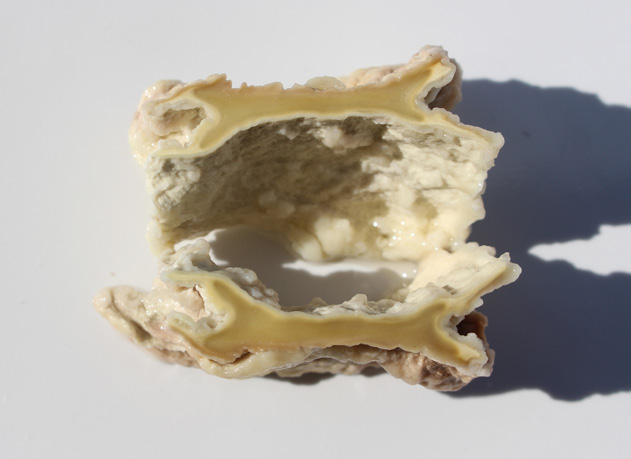
The arrival of these mushrooms brought on a lot of experimentation. We cured them in salt and sugar. We cured them in beetroots. We made tinctures. We dehydrated them. We cured and hung some like sausages. We lacto-fermented them with other aromatics. We fermented them in buttermilk. We even made ‘french toast’ out of them (it was actually quite good). And then we inoculated them with shio-koji…
Although some preparations provided tasty results, they paled in comparison to the puffball mushrooms that we cured with shio-koji. Shio-koji is a mixture of sea salt (shio), koji, and water. It is a popular condiment in Japan, and has a variety of uses, making use of its rich enzymatic activity from the koji. It is used in anything from salad dressing, to marinade, or even in crêpe batter. With this application, we found the most success with the following method:
Ingredients
Shio-koji
Giant puffball mushroom
(use a ratio of 1:2.4 (w/w) shio-koji:mushroom)
Equipment
Brush
Vacuum Sealer
Muslin
Butcher’s Twine
Dehydrator
Method
Clean the exterior of the puffball mushroom. We simply trimmed and discarded it.
Cut the mushroom into large pieces. Ours were approximately 150g each.
Gently brush the mushroom with shio koji using the above ratio. The mushrooms are extremely delicate, and it is important that you keep the mushroom whole.
Place in an appropriately-sized vacuum bags, and seal (100%).
Place in a refrigerator at 4˚C for 72 hours.
After 72 hours, remove from the bag, and place the mushroom in a small pouch made of muslin.
Tie the pouch closed with twine, and hang in a room at ±20˚C for 48 hours.
After 48 hours, remove the mushroom from the pouch and dehydrate at 55˚C for 6-8 hours. Alternatively, you can dehydrate the mushroom to your desired texture. The longer you dehydrate, of course, the drier and harder it will become.
Sensory Results
We found that after 6 hours the mushroom’s texture is just unbelievable. It’s actually hard to explain because the transformation is a bit extreme. The shio koji seems to have been a catalyst for some pretty intense amino acid breakdown. The texture is soft, but slightly elastic, it is similar to well-made mozzarella in this way. However, the color is deep amber, similar to honey. The taste is pleasant, but very unusual. There are hints of salt, earth, caramel, and aged gouda. It’s quite a dominant taste, and therefore better suited to consume in thin slices.
After 24 hours of dehydration at 55˚C, the mushroom is a bit drier, but when microplaned, it is also quite nice. With this texture it is well suited to microplane on whatever you’d like—eggs, pasta, or scallion pancakes might be a nice place to start.
The obvious next step in this process was to try and use this product in a composed dish.
This was actually a bit more difficult than anticipated. This process in particular could be compared to putting together a jigsaw puzzle. The cured puffball mushroom has been the very oddly shaped piece that takes a while to place. The texture and taste are quite novel, and as a result, hard to pair with complimentary ingredients. But a challenge is always a good thing.
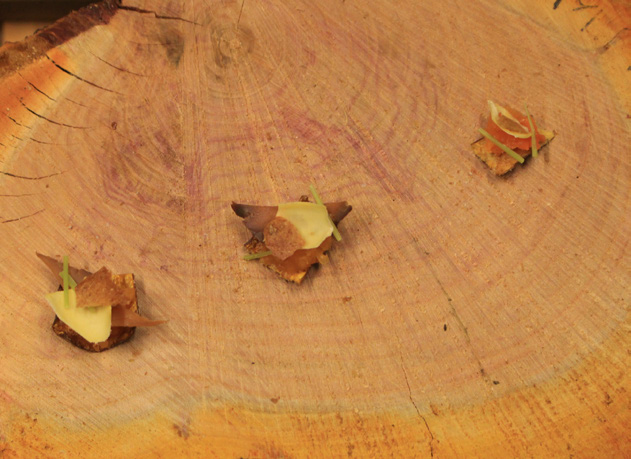
The first dish we tried included a squash (cooked in oxidised pork fat), with a dehydrated chip of sourdough starter and fermented cabbage juice. The ingredients were then garnished with some puffball tincture, elderberry vinegar, and nasturtium stems. I suppose the idea was to embrace the ‘seasons’ (winter) with this combination. I may have also been trying to utilize this unusual fermented cabbage juice we made (that is so weird, but very interesting and tasty). The dish was ok.
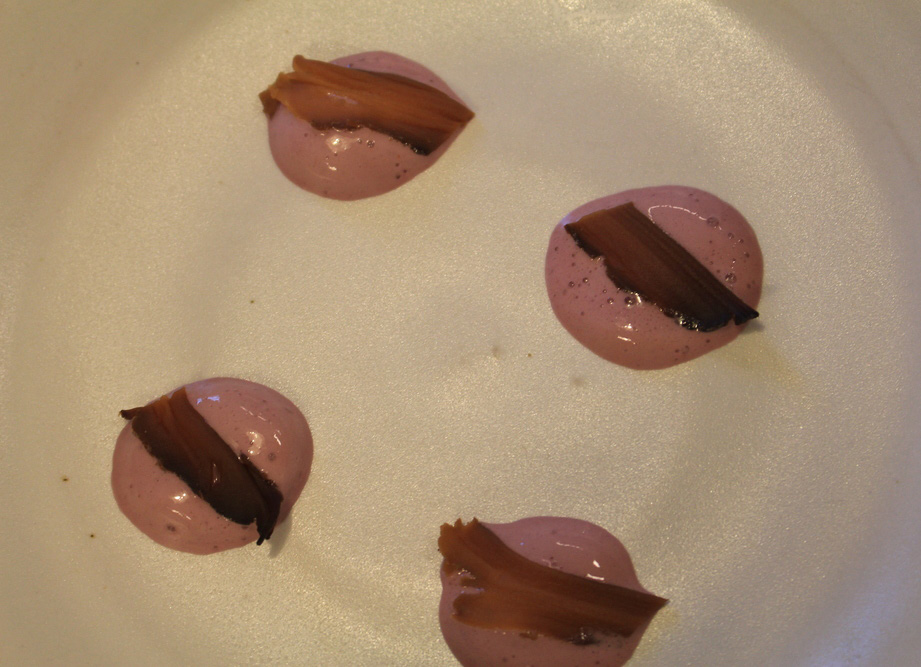
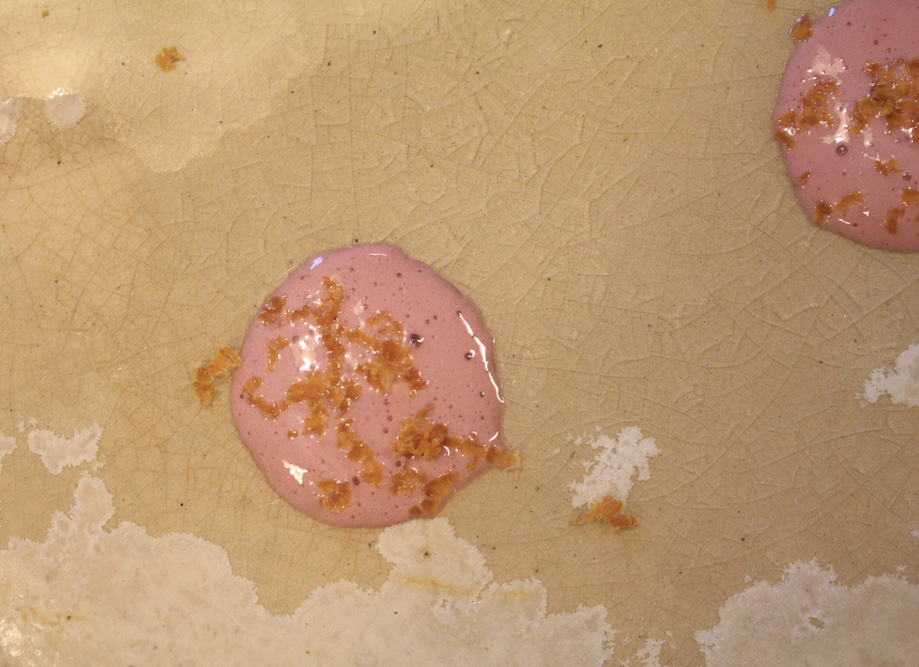
‘Ok’ isn’t really good enough, so we went back to the drawing board. We thought about the origin of these mushrooms – maybe the mushrooms natural habit could give us some clues. The puffball mushrooms had been discovered amongst elderberry trees, so trying a combination of the two seemed like a plausible idea. I made a light ‘meringue’ of egg whites and our Older Elder vinegar, and served it with a slice of the mushroom. Simple. But, sensory results were underwhelming.
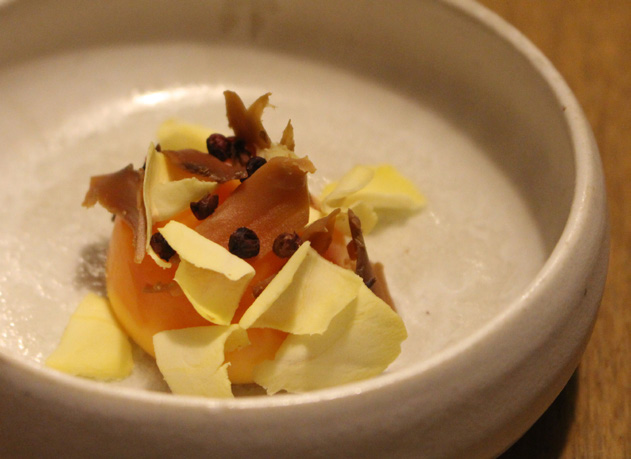
After that we moved into new territory. We used a soft cooked egg yolk as the ‘center’ of the dish and then placed thin slices of chestnuts (raw, pickled in elder vinegar, and preserved in puffball tincture), and puffball slices on top as well. The combination of ingredients was tasty—however, the egg yolk was a bit cloying on the palate. This was the first test dish that was well-received, visually, as well as hedonically.
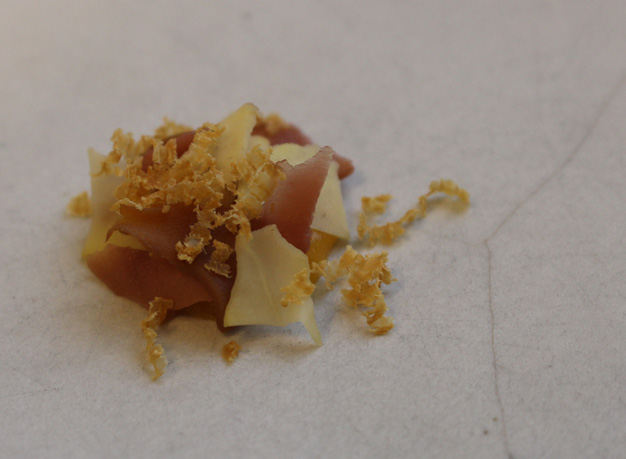
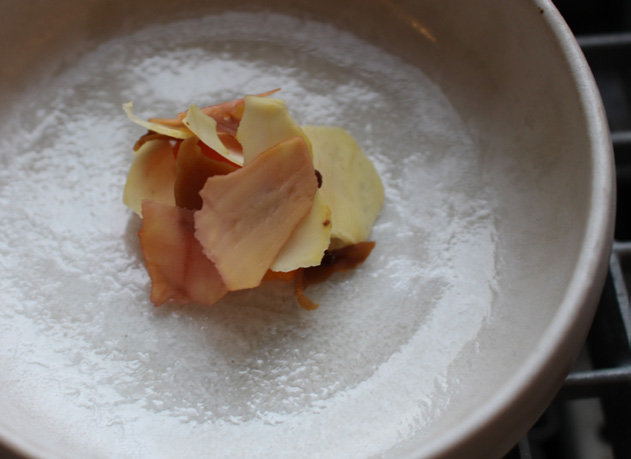
The combination of tastes and textures was pleasant, and the puffball taste was recognizable but not dominant. We liked this dish. Although it wasn’t perfect, we thought that it was a nice snack. What is a perfect dish anyway? Does such a thing exist? (Yes, it’s the egg yolk, corn broth, and black pepper oil dish at AMASS). In any case, I’m sure many cooks can relate to the idea that a dish is never really finished.
Seasons change. There will be many more dishes that can be created with this puffball mushroom, and those will come in time. For now, these shio-koji-cured puffballs have taken their well-earned place in our pantry. We will see how they develop.
References
Bachmanov, A.A., and G.K. Beauchamp. 2007. Taste receptor genes. Annu. Rev. Nutr. 27: 389-414.
Berkley, M. J. (1857). Introduction to cryptogamic botany. In H Bailliere (Ed.), Food Ingredient (pp. 69–85). J (Japan) 167 London.
Bresinsky A, Besl H. A Colour Atlas of Poisonous Fungi: A Handbook for Pharmacist, Doctor and Biologist. London: Wolf Publishing Ltd; 1990.
Chen ZH, Zhang P, Zhang ZG. Investigation and analysis of 102 mushroom poisoning cases in southern China from 1994 to 2012. Fungal Divers. 2013;64(1):123–131.
Karlson-Stiber, C., & Persson, H. (2003) Cytotoxic fungi — an overview. Toxicon, 42, pp. 339–349
Kasabian, D., and A. Kasabian. (2005). The Fifth Taste, Cooking with Umami. New York: Universe Publishing.
Kim, Kyoungju ; Choi, Byungsun ; Lee, Inhee ; Lee, Hyeyoung ; Kwon, Soonhyang ; Oh, Kyoungyoung ; Kim, Augustine ; Kim, Kyoungju (correspondence author) Bioproduction of mushroom mycelium of Agaricus bisporus by commercial submerged fermentation for the production of meat analogue. Journal of the Science of Food and Agriculture, Jul 2011, Vol.91(9), pp.1561-1568
Kivrak, I., Kivrak, S., and Harmandar, M. 2014. Free amino acid profiling in the giant puffball mushroom (Calvatia gigantea) using UPLC–MS/MS. Food Chemistry 158 (2014) 88–9
Manzi, P.; Gambelli, L.; Marconi, S.; Vivanti, V.; Pizzoferrato, L. Nutrients in edible mushrooms: an inter-species comparative study. Food Chem. 1999, 65, 477-482.
Manzi, P.; Marconi, S.; Aguzzi, A.; Pizzoferrato, L. Commercial mushrooms: nutritional quality and effect of cooking. Food Chem. 2004, 84, 201-206.
Mattila, P.; Suonpää, K.; Piironen, V. Functional properties of edible mushrooms. Nutrition 2000, 16, 694-696.
Mattila, P.; Salo-Väänänen, P.; Könkö, K.; Aro, H.; Jalava, T. Basic composition and amino acid contents of mushrooms cultivated in Finland. J. Agric. Food Chem. 2002, 50, 6419- 6422.
McWilliams, M. (2012). Foods Experimental Perspectives (7th ed.) New Jersey: Pearson Education, Inc.
Petersen, J. (2012) The Kingdom of Fungi. Princeton, NJ: Princeton University Press.
Rai, M., Tidke, G., & Wasser, S. P. (2005). Therapeutic potential of mushrooms. Natural Products Radiance, 246– 257.
Roberts DM, Hall MJ, Falkland MM, Strasser SI, Buckley NA. Amanita phalloides poisoning and treatment with silibinin in the Australian Capital Territory and New South Wales. Med J Aust. 2013;198(1):43–47.
Rubel, W. and Arora, D. 2008. A Study of Cultural Bias in Field Guide Determinations of Mushroom Edibility Using the Iconic Mushroom, Amanita muscaria, as an Example. Economic Botany 62(3): 223–243.
Schenk-Jaeger, Km ; Rauber-Luthy, C ; Bodmer, M ; Kupferschmidt, H ; Kullak-Ublick, Ga ; Ceschi, A. (2012) Mushroom poisoning: A study on circumstances of exposure and patterns of toxicity. European Journal Of Internal Medicine. June, Vol.23(4), pp.E85-E91
Unluoglu I, Tayfur M. Mushroom poisoning: an analysis of the data between 1996 and 2000. Eur J Emerg Med. 2003;10(1):23–26.
Valentão, P. ; Lopes, G. ; Valente, M. ; Barbosa, P. ; Andrade, P.B. ; Silva, B.M. ; Baptista, P. ; Seabra, R.M. (2005). Quantitation of nine organic acids in wild mushrooms. Journal of Agricultural and Food Chemistry, Vol.53(9), pp.3626-3630
Ward J, Kapadia K, Brush E, Salhanick SD. Amatoxin poisoning: case reports and review of current therapies. J Emerg Med. 2013;44(1):116–121. [PubMed]
